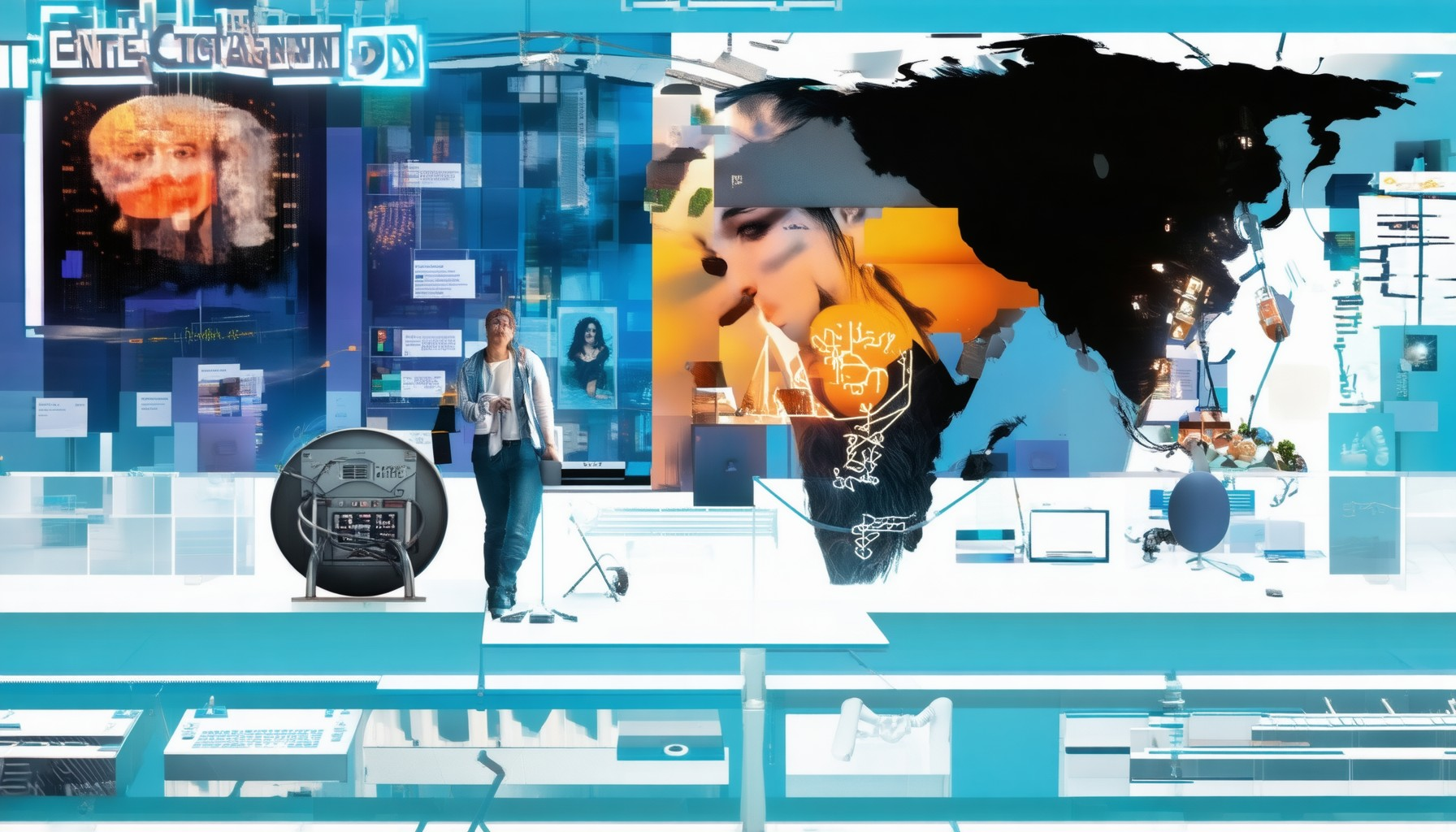The entertainment industry continues to evolve rapidly, shaped by shifting consumer preferences, technological advancements, and economic factors. As we step into 2024, the landscape of media and entertainment is poised for significant transformations, offering both challenges and opportunities for stakeholders across the board. From the rise of streaming platforms to the growing demand for personalized content, the industry is adapting to meet the needs of a global audience.

The State of the Entertainment Industry in 2024
The entertainment industry continues to evolve rapidly, driven by technological advancements and shifting consumer preferences. Here’s a breakdown of the current landscape:
Movies
Hollywood studios are increasingly focusing on diverse storytelling and inclusive narratives to cater to global audiences. The return of major blockbusters like “Barbie” and “Dune: Part Two” has shown a resurgence in big-screen experiences, though streaming platforms remain dominant in content consumption.
Television
Subscription-based streaming services continue to dominate the TV landscape, with platforms like Netflix and Disney+ investing heavily in original content. Series like “House of the Dragon” and “Stranger Things” have proven to be major draws, driving competition among streaming platforms to secure high-quality productions.
Streaming Platforms
Streaming platforms are now the primary destination for entertainment consumers. Services like Netflix, Amazon Prime Video, and Disney+ are leading the charge, with each investing billions in content acquisition and production. Original programming has become a cornerstone of their strategy, ensuring loyal fanbases and recurring revenue streams.
Live Events
Live events, particularly in music and sports, are making a strong comeback. Concerts, sports games, and theater performances are seeing record attendance as COVID-19 restrictions ease. Virtual events, while still popular, are now complementing in-person gatherings rather than replacing them entirely.
Music
Music streaming services like Spotify and Apple Music are reshaping the industry, with artists relying less on physical sales and more on digital distribution. Platforms are also leveraging AI-driven recommendations to curate personalized playlists and discover new talent, fostering connections between artists and fans.
Competitive Landscape
The entertainment industry remains highly competitive, with tech giants like Amazon, Netflix, and Disney vying for dominance. Independent filmmakers and content creators are also thriving, thanks to accessible tools and platforms that allow them to produce high-quality work without traditional studio backing.
Future Outlook
Looking ahead, the entertainment industry is expected to see continued growth, particularly in streaming and digital content delivery. Studios and creators will likely focus on producing more niche and culturally relevant content to capture a broader audience. The integration of AI and advanced data analytics will play a crucial role in shaping future entertainment trends.
For more insights into the latest trends and innovations in the entertainment industry, visit 1 Nation Entertainment .
Media and Entertainment Outlook for 2024
In 2024, the media and entertainment industry is poised for significant growth and transformation, driven by evolving consumer preferences, technological advancements, and shifting market dynamics. Here’s a breakdown of the key trends and opportunities:
Technological Advancements
The integration of artificial intelligence (AI), virtual reality (VR), and augmented reality (AR) will continue to revolutionize the industry. Studios and creators are increasingly leveraging these technologies to enhance storytelling, immersive experiences, and personalized content delivery.
- A.I.-driven content recommendations will dominate streaming platforms, ensuring users receive tailored suggestions based on viewing habits.
- Virtual and augmented reality experiences will become mainstream, particularly in live events, gaming, and virtual concerts.
- Advanced analytics tools will enable better understanding of audience behaviors, enabling more data-driven content creation and marketing strategies.
Shifts in Consumer Behavior
Consumers are demanding more personalized and on-demand content across multiple platforms. This trend is driving the rise of subscription-based services and ad-supported tiers on streaming platforms.
- Subscription-based models will continue to dominate the market, with services offering unique niche content catering to specific demographics.
- Interactive and user-generated content will gain traction, as platforms leverage social media integrations to foster community engagement.
- There will be a greater emphasis on original content production to differentiate services and retain subscribers.
Sustainability and Ethical Production
Environmental concerns are reshaping production practices, with studios adopting greener technologies and reducing carbon footprints. This trend is expected to accelerate, supported by regulatory pressures and consumer demand for ethically produced content.
- Production companies are investing in sustainable practices, such as energy-efficient equipment and recycling programs.
- Consumers are increasingly favoring brands that align with environmental values, leading to a shift in purchasing behaviors.
- Ethical storytelling and representation will become a key factor in content creation, ensuring diverse and inclusive narratives.
Global Expansion and Localization
International markets will play a crucial role in the industry’s growth, with global streaming platforms expanding into emerging regions. Simultaneously, localized content creation will rise to meet the needs of regional audiences.
- Global streaming platforms are investing heavily in local language dubbing, subtitles, and original content to cater to international audiences.
- Regional content creators will benefit from increased visibility and funding, fostering cultural diversity in entertainment offerings.
- Collaborations between global studios and local talent will drive innovation and reach new demographic segments.
Innovation in Content Creation
Creators and influencers will continue to shape the industry, leveraging their personal brands to produce high-quality, niche-focused content. Platforms are also investing in tools to support independent creators and small productions.
- Independent creators are gaining access to better distribution channels and monetization opportunities, reducing reliance on traditional intermediaries.
- Platform-native content formats, such as short-form videos and series, are becoming popular among younger audiences.
- Collaborative projects between established stars and rising talents will bring fresh perspectives to entertainment.

Forecast for the Entertainment Industry
The entertainment industry continues to evolve rapidly, driven by technological advancements and shifting consumer preferences. According to recent market analyses, the global entertainment industry is projected to grow significantly over the next five years.
Growth Projections
- From 2023 to 2024, the industry expanded from USD 4.34 billion to USD 5 billion, reflecting a growth rate of approximately 15.8%.
- Over the next five years (2025-2030), the sector is anticipated to grow at a compound annual growth rate (CAGR) of 16.10%, reaching a market size of USD 12.34 billion by 2030.
Key Growth Drivers
- Technological Innovation: The rise of AI-driven content creation, virtual reality (VR), and augmented reality (AR) is transforming how entertainment is consumed and produced.
- Streaming Dominance: The continued shift towards online streaming services has increased competition among platforms like Netflix, Disney+, and Amazon Prime Video.
- Live Events Recovery: Post-pandemic, the demand for live concerts, sports events, and theater performances has surged, driving growth in the live entertainment sector.
- Consumer Spending Increases: Rising disposable incomes and the growing popularity of entertainment as a leisure activity are fueling industry expansion.
Competitive Landscape
The entertainment industry is highly competitive, with major players like Netflix , Disney+ , and Amazon Prime Video leading the charge in streaming. In the music and event space, companies like Spotify , Ticketmaster , and Universal Music Group are key contenders.
Future Outlook
As technology continues to shape the future of entertainment, industries ranging from traditional media to emerging platforms will play pivotal roles in defining market dynamics. Staying ahead of consumer trends and leveraging innovative tools will be essential for sustained growth and relevance in this dynamic sector.

Outlook for PwC E&M
The global entertainment and media (E&M) sector is poised for steady growth over the next few years, driven by evolving consumer preferences and technological advancements. According to recent industry analyses, PwC E&M is well-positioned to capitalize on these trends, with projections indicating a compound annual growth rate (CAGR) of 3.9% from 2024 to 2028. By 2028, the combined revenue of the E&M complex is expected to surpass $3.4 trillion, reflecting a balanced growth trajectory.
Key Growth Drivers:
- Digital Transformation : The shift towards digital content consumption is a cornerstone of PwC E&M’s growth strategy. From streaming services to virtual events, the demand for innovative digital solutions is driving investment in cutting-edge technologies.
- Content Consumption Trends : Audiences are increasingly seeking personalized and niche content, creating opportunities for PwC E&M to develop tailored entertainment experiences.
- Global Expansion : PwC E&M is leveraging its international footprint to tap into emerging markets, particularly in Asia-Pacific and Latin America, where entertainment consumption patterns are rapidly evolving.
Competitive Landscape:
While PwC E&M competes with major players like Deloitte, KPMG, and McKinsey, its focus on delivering end-to-end solutions gives it a unique edge. These competitors also offer robust services, but PwC’s ability to integrate entertainment, media, and technology solutions under one roof positions it as a preferred partner for clients.
Future Outlook:
The next five years will see PwC E&M focusing on innovation in production, distribution, and monetization strategies. The company is likely to invest heavily in AI-driven tools to enhance content creation and audience engagement. Additionally, partnerships with emerging platforms and technologies will play a pivotal role in shaping its future growth.
For more insights into the global entertainment and media landscape, explore 1 Nation Entertainment and discover how we’re shaping the future of entertainment.
Is it prestigious to work for PwC?
PwC (PricewaterhouseCoopers) is one of the most prestigious professional services firms globally, renowned for its expertise in auditing, consulting, and financial services. Working for PwC can be viewed as prestigious due to several factors:
Global Reputation and Prestige
PwC is a member of the “Big Four” audit firms, which are highly regarded in the financial and corporate sectors. Its global footprint and extensive client base, including many of the world’s largest corporations, contribute to its prestigious status.
High-Quality Work and Impact
Employees at PwC often work on high-profile engagements with major organizations, providing them with the opportunity to tackle complex challenges and make meaningful contributions to clients’ success.
Career Advancement Opportunities
PwC is known for offering robust career development programs and leadership opportunities, attracting ambitious professionals who seek to grow their skills and expertise in a dynamic environment.
Strong Employer Brand
The firm consistently ranks highly in surveys measuring employer reputation, further solidifying its position as a prestigious place to work. PwC’s commitment to innovation and diversity also enhances its appeal among talented individuals.
Networking and Connections
Working for PwC provides access to a vast network of professionals, industry leaders, and clients, which can be invaluable for career advancement and building long-term business relationships.
In summary, working for PwC is considered prestigious due to its global reach, respected brand, and the caliber of work performed by its employees. However, the perception may vary slightly depending on the specific role and location within the firm.

Media Industry Trends in 2025
The media landscape in 2025 is characterized by rapid evolution driven by technological advancements and shifting consumer preferences. Here are the key trends shaping the industry:
1. Rise of Short-Form Video Content
Short-form video platforms like TikTok and Instagram Reels continue to dominate the media consumption landscape. Brands are increasingly investing in creative, bite-sized content to capture younger audiences. Platforms are also introducing ad formats tailored for these formats, enabling more dynamic and engaging campaigns.
2. AI-Powered Search and Discovery
AI is revolutionizing how content is discovered. Algorithms powered by AI are becoming more sophisticated, allowing users to find niche content with greater precision. This shift is driving changes in how media companies curate and recommend content, creating opportunities for personalized and hyper-targeted recommendations.
3. Growth of Retail Media Networks
Retail media networks are gaining traction as brands look to integrate content with commerce. Companies like Walmart and Amazon are expanding their media offerings, blending shopping experiences with content consumption. This trend is expected to accelerate, with more retailers adopting hybrid models that combine physical and digital experiences.
4. Enhanced Mobile Experiences
Mobile remains the primary access point for media consumption. Media companies are focusing on optimizing content for smaller screens, faster load times, and better engagement. Innovations in mobile video streaming and interactive content are reshaping how consumers interact with media.
5. Expansion of Audio Content
Audio content, particularly podcasts and audiobooks, is experiencing significant growth. With increasing competition for attention, audio media is becoming a preferred choice due to its portability and ease of consumption. Major platforms are investing heavily in producing high-quality audio content.
6. Rise of Branded Content
Branded content is playing a pivotal role in marketing strategies. Companies are creating custom content that aligns with their brand values and resonates with target audiences. This trend is driving demand for content creation tools and services that help businesses produce high-quality branded content efficiently.
7. Increased Focus on Sustainability
Sustainability is becoming a key consideration for media companies. From reducing carbon footprints to promoting eco-friendly practices, organizations are adopting measures to minimize their environmental impact. This shift is influencing production decisions, distribution channels, and content themes.
8. Globalization of Content
Content is becoming more globalized, with media companies adapting to diverse audiences. Localization strategies are becoming essential as companies seek to tap into international markets. This trend is driving investment in translation services, cultural insights, and content adaptation tools.
9. Integration of AR and VR
Augmented Reality (AR) and Virtual Reality (VR) are being integrated into media experiences. These technologies are enhancing immersive content, offering new ways for audiences to engage with stories, games, and virtual events. Media companies are experimenting with AR/VR to create unique and memorable experiences.
10. Focus on User-Generated Content
User-generated content is gaining momentum as a cost-effective and authentic marketing tool. Platforms are fostering communities around specific niches, enabling brands to leverage the trust and influence of their audiences. This trend is reshaping content creation and consumption patterns.
Conclusion
The media industry in 2025 is undergoing a transformative phase, driven by technological innovations and changing consumer behaviors. As the sector evolves, media companies must stay adaptable, invest in emerging technologies, and focus on creating value for their audiences to remain competitive.




